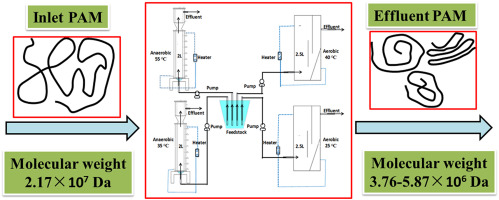当前位置:
X-MOL 学术
›
Chemosphere
›
论文详情
Our official English website, www.x-mol.net, welcomes your
feedback! (Note: you will need to create a separate account there.)
Cleavage of the main carbon chain backbone of high molecular weight polyacrylamide by aerobic and anaerobic biological treatment
Chemosphere ( IF 8.1 ) Pub Date : 2017-09-18 , DOI: 10.1016/j.chemosphere.2017.09.079 Wenzhe Song , Yu Zhang , Yingxin Gao , Dong Chen , Min Yang
Chemosphere ( IF 8.1 ) Pub Date : 2017-09-18 , DOI: 10.1016/j.chemosphere.2017.09.079 Wenzhe Song , Yu Zhang , Yingxin Gao , Dong Chen , Min Yang

|
High molecular weight partially hydrolyzed polyacrylamide (PAM) can be bio-hydrolyzed on the amide side group, however, solid evidence regarding the biological cleavage of its main carbon chain backbone is limited. In this study, viscometry, flow field-flow fractionation multi-angle light scattering (FFF-MALS), and attenuated total reflectance-Fourier transform infrared (ATR-FTIR) analysis were used to investigate the biodegradability of PAM with a nominal molecular weight of 2 × 107 Da (Da) in two suspended aerobic (25 and 40 °C) and two upflow anaerobic blanket reactors (35 and 55 °C) operated for 470 d under a hydraulic residence time (HRT) of 2 d. Both anaerobic and aerobic biological treatment reduced the viscosity from 2.02 cp in the influent to 1.45–1.60 cp, and reduced the molecular weight of PAM using FFF-MALS from 2.17 × 107 Da to less than one-third its original size. The removals of both the amide group and carbon chain backbone in the PAM molecule were further supported by the FTIR analysis. In comparison with the other conditions, thermophilic anaerobic treatment exhibited higher efficiency for PAM biodegradation. Batch test excluded the influence of temperature on the molecular weight of PAM over the range 25–55 °C, suggesting that cleavage of the main carbon chain backbone was attributed to biological degradation. Our results suggested that high molecular weight PAM was biodegradable, but mineralization did not occur.
中文翻译:

通过好氧和厌氧生物处理裂解高分子量聚丙烯酰胺的主要碳链主链
高分子量部分水解的聚丙烯酰胺(PAM)可以在酰胺侧基上进行生物水解,但是,有关其主要碳链主链生物裂解的可靠证据有限。在这项研究中,使用粘度测定法,流场-流分离多角度光散射(FFF-MALS)和衰减全反射-傅立叶变换红外(ATR-FTIR)分析来研究标称分子量为的PAM的生物降解性。 2×10 7 在两个悬浮的需氧(25和40°C)和两个上流厌氧毯式反应器(35和55°C)中的Da(Da)在2 d的水力停留时间(HRT)下运行470 d。厌氧和好氧生物处理均将进水的粘度从2.02 cp降低到1.45-1.60 cp,使用FFF-MALS的PAM分子量从2.17×10 7降低 达不到其原始大小的三分之一。FTIR分析进一步支持了PAM分子中酰胺基和碳链主链的去除。与其他条件相比,嗜热厌氧处理表现出更高的PAM生物降解效率。批量测试排除了温度对25–55°C范围内PAM分子量的影响,这表明主要碳链主链的裂解归因于生物降解。我们的结果表明,高分子量PAM是可生物降解的,但没有发生矿化。
更新日期:2017-09-19
中文翻译:

通过好氧和厌氧生物处理裂解高分子量聚丙烯酰胺的主要碳链主链
高分子量部分水解的聚丙烯酰胺(PAM)可以在酰胺侧基上进行生物水解,但是,有关其主要碳链主链生物裂解的可靠证据有限。在这项研究中,使用粘度测定法,流场-流分离多角度光散射(FFF-MALS)和衰减全反射-傅立叶变换红外(ATR-FTIR)分析来研究标称分子量为的PAM的生物降解性。 2×10 7 在两个悬浮的需氧(25和40°C)和两个上流厌氧毯式反应器(35和55°C)中的Da(Da)在2 d的水力停留时间(HRT)下运行470 d。厌氧和好氧生物处理均将进水的粘度从2.02 cp降低到1.45-1.60 cp,使用FFF-MALS的PAM分子量从2.17×10 7降低 达不到其原始大小的三分之一。FTIR分析进一步支持了PAM分子中酰胺基和碳链主链的去除。与其他条件相比,嗜热厌氧处理表现出更高的PAM生物降解效率。批量测试排除了温度对25–55°C范围内PAM分子量的影响,这表明主要碳链主链的裂解归因于生物降解。我们的结果表明,高分子量PAM是可生物降解的,但没有发生矿化。











































 京公网安备 11010802027423号
京公网安备 11010802027423号